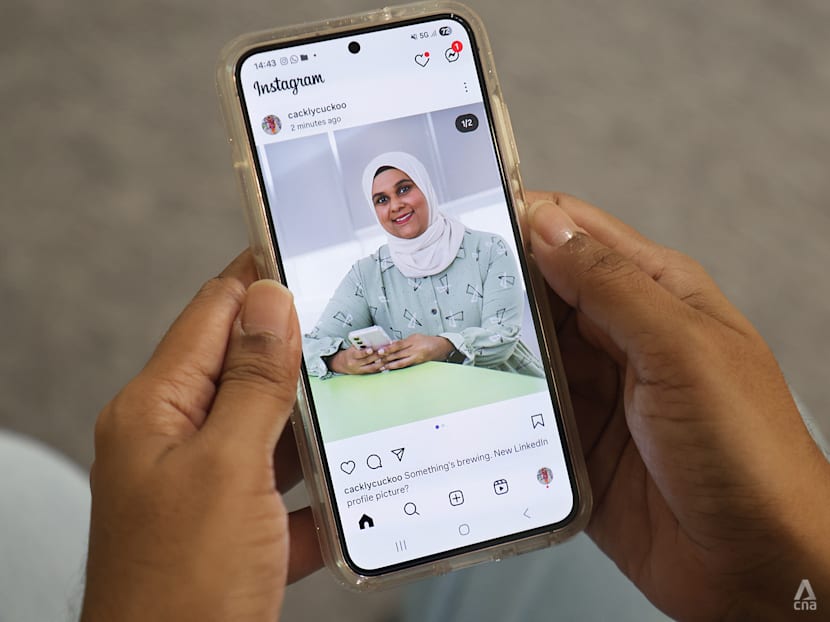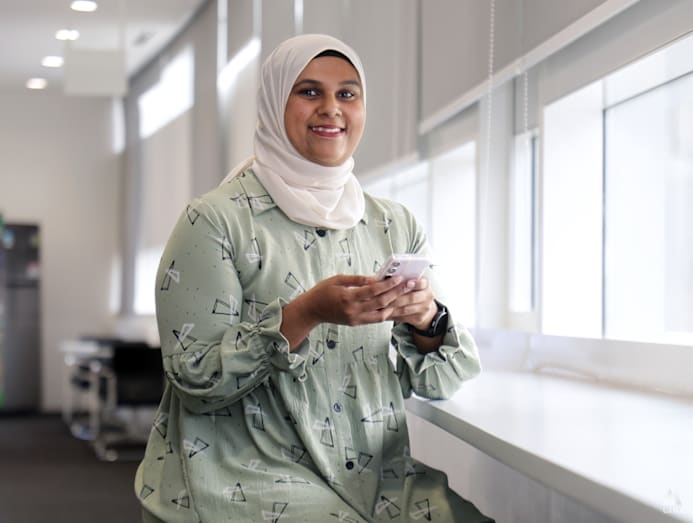Why I started 'ugly' posting again on Instagram
CNA's Jalelah Abu Baker is from the pioneer generation of social media – the first on Friendster and Facebook. Now, in the age of influencers and carefully crafted content, she wonders what has happened to the fun of making permanent memories online.

CNA's Jalelah Abu Baker looks at a photo of herself posted to her Instagram account on Oct 30, 2025. (Photo: CNA/Ooi Boon Keong)

This audio is generated by an AI tool.
What's your favourite social media platform? Industry data shows that most people would have the same answer as me: Instagram.
I've been on Instagram since its early days, from when the app icon was the original brown Polaroid camera. I was there before Threads and Stories, before you could even post videos on the platform.
And I'm clearly not sick of it yet – according to my phone's logs, I average about three hours a day on the app.
In the beginning, what lured me was the main character energy of photo-driven posts. They felt more intentional and less rapid-fire than Twitter, and less inane than Facebook which, at the time, was flooded with "Just had my lunch" sort of updates.
But over the years, it began to change.
My Instagram feed of 2025 looks very different from what it was in 2015. It's full of self-professed "professionals" and "experts" in several fields, teaching or promoting everything from strength training to make-up techniques to parenting methods.
Personal updates from friends and loved ones used to be my raison d'etre for being on Instagram – now they're rare finds in a sea of content.
I'm part of this paradox as well: I'm spending more time than ever on Instagram. But why am I posting so much less than before?
WHEN SOCIAL MEDIA WAS SOCIAL
I'm from the pioneering generation of social media users. We were the first to write Friendster testimonials for each other, to Facebook "poke" each other and to let go of inhibitions over sharing private details online.
Eating? Post a photo. Dating? Update my status. Fighting? Put up cryptic song lyrics.
When Instagram arrived, it upped the game.

I made my very first Instagram post on Jan 31, 2013.
It was a photo of myself with the karang guni man, a traditional scrap dealer, who used to playfully scare me when I was a child. It was taken when I bumped into him again in my twenties.
He reminded me of simpler and more carefree days – what my old block looked like before our whole estate underwent en bloc, and the way my late mother would always turn over old newspapers to him.
This was the original appeal of Instagram for me and so many of my peers: More than just pictures and videos, we could share the stories behind them that made the visuals so memorable.
We went into a tizzy sharing visual snippets of our lives, often accompanied with hashtags. For my baking and cooking photos, I used the hashtags #jalelahabubaker and #jalelahabucooker.
INSTAGRAM, MY OLD FRIEND
In July 2017, I posted a short video with the caption: "When you can't go on your planned trip to India, but you have the whole ferry to Batam to yourself."
What's not shown or explained there is how my husband and I had turned up at the airport at 3.45am for our early flight to India without a visa.
We did not know we'd needed one. But instead of fighting or blaming each other – which we were very tempted to do – we sat down and booked a trip we could still go on.
Watching that video of the empty ferry still makes us laugh.

Sometimes, my Instagram posts are all I have.
In 2019, I encountered a data backup glitch when I was switching to a new phone. Hundreds of pictures from my life – a work trip to Osaka, Japan, my first time venturing onto Australia's Great Ocean Road, a family trip to Langkawi, Malaysia – were all wiped out.
I did not expect to grieve them, but grieve I did.
But even though I'd lost the memories captured in my old phone, I still had the few Instagram posts I'd made during those trips – a small but unexpected source of solace.
Instagram is also where I first found the courage to post videos of myself dancing. Such videos may be a dime a dozen now on TikTok but they weren't quite as common in the mid-2010s, unless they featured professional dancers or girls who fitted squarely into conventional standards of beauty, especially in terms of their size.
I spent many years keeping up with friends' lives through their Instagram posts. The work updates, the marriage proposals, weddings, pets, births and even deaths.
But somewhere along the way, sharing the flawed aspects of our lives quietly became … socially unacceptable.
FROM SOCIAL TO SELF-CONSCIOUS
We started sharing only the best-looking, most perfectly-filtered snapshots of ourselves and what we did.
We became more and more conscious of how many likes and comments we were getting (or not getting).
Hashtags became cringe, used only by corporate brands and Gen Xers trying too hard to seem like "one of us".
A fun way to connect started feeling more like work. Instagram became too curated, too fake – especially once we entered the era of social media influencers.
I started second-guessing if my memories were "good enough" to share. I stopped posting as frequently.
I gave in to an invisible pressure to "perfect" my own Instagram presence, even though I've never had thoughts of becoming an influencer myself. (Even now, my account – which remains private – has just 585 followers.)
My Instagram feed was no longer a space I could call mine.
I often found myself struggling with the meanings and implications behind each post and almost-post.
I'd ask myself: "Am I only posting my happy moments? Is this an accurate depiction of my life? Is it too positive, too curated? Am I looking for validation?"
In search of answers or perhaps driven by a fear of finding them, I turned to the Stories feature more – temporary posts that would typically disappear after 24 hours.
These felt safer. It didn't matter if anything I posted as a Story didn't "perform" the way I was hoping. It would simply disappear from my page by the next day.
Even then, I posted these only very sporadically.
CAN MY INSTAGRAM FEED BE MINE AGAIN?
Recently, a former classmate made an announcement on Instagram that felt like a kick in my millennial gut: Her posts had disappeared from her page, not because she had been hacked but because she had willingly deleted them.
She archived the posts she wanted. She can still see them, privately.
Her announcement inspired me to go on a walk down the memory lane of my own Instagram account. What I saw was all the seasons of my life (in the past 12 years) gathered together in a nifty little space.
But what I didn't expect was the pang of sadness at the gaping holes in my page from when I was going through my phase of fear of cringe.
Now, I look through my photos from those years and see so many milestones – of joy and pain – that deserved a space on my virtual wall.
I decided that I was going to post again. Whatever I wanted, as frequently as I wanted, overcoming my own hesitation.

My page is still a little slice of the internet I can call my own. It's not just about documenting my life, but allowing the imperfect parts of it to take up more space, regardless of likes and comments.
It's becoming a way for me to reconnect with myself, to find my own experiences and memories worthy of sharing or displaying, even if just for my friends and loved ones.
These seemingly inane posts may not seem particularly pretty or eye-catching on their own, but they come together to form the rich tapestry of who I am – and will continue to do so even when I am gone.
Jalelah Abu Baker is an editor at CNA TV.
If you have an experience to share or know someone who wishes to contribute to this series, write to voices [at] mediacorp.com.sg (voices[at]mediacorp[dot]com[dot]sg) with your full name, address and phone number.












